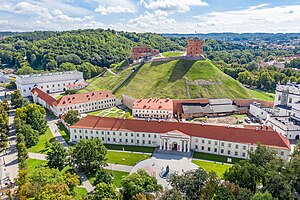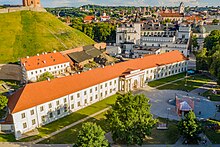
Rasos Cemetery is the oldest and most famous cemetery in the city of Vilnius, Lithuania. It is named after the Rasos district where it is located. It is separated into two parts, the old and the new cemeteries, by a narrow Sukilėliai Street. The total area is 10.8 ha. Since 1990 new burials are allowed only to family graves.
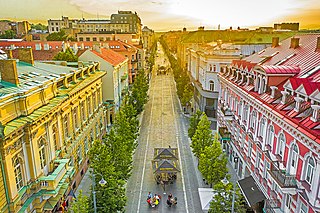
Gediminas Avenue is the main street of Vilnius, where most of the governmental institutions of Lithuania are concentrated, including the government, parliament, Constitutional Court and ministries. It is also the location of cultural institutions such as the Lithuanian National Drama Theatre, Bank of Lithuania, Lithuanian Academy of Music and Theatre and Martynas Mažvydas National Library. It is also a popular shopping and dining street. It is partially a pedestrian street in the evenings when traffic is prohibited.

Jonas Basanavičius was an activist and proponent of the Lithuanian National Revival. He participated in every major event leading to the independent Lithuanian state and is often given the informal honorific title of the "Patriarch of the Nation" for his contributions.

Count Eustachy Tyszkiewicz, Leliwa coat of arms, was a Polish noble from the Tyszkiewicz family. He was an archaeologist and historian of the former Grand Duchy of Lithuania and White Ruthenia, then part of the Russian Empire. He is considered the first archaeologist to have undertaken a systematic study of historical sites in Belarus and Lithuania, and was highly influential on succeeding generations of archaeologists. In 1855 he founded the Museum of Antiquities in Vilnius, which is regarded as the predecessor institution of the National Museum of Lithuania. He donated his personal collection of archaeological and historical artifacts to start the museum. He was a younger brother of historian Konstanty Tyszkiewicz.
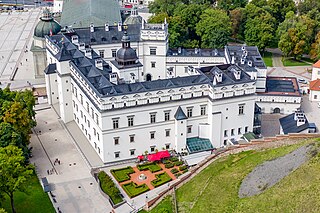
The Palace of the Grand Dukes of Lithuania is a palace in Vilnius, Lithuania. It was originally constructed in the 15th century for the rulers of the Grand Duchy of Lithuania and the future Kings of Poland. The palace, located in the lower castle of Vilnius, evolved over the years and prospered during the 16th and mid-17th centuries. For four centuries the palace was the political, administrative and cultural centre of the Polish–Lithuanian Commonwealth. It was demolished in 1801.

The Vilnius Castle Complex is a group of cultural, and historic structures on the left bank of the Neris River, near its confluence with the Vilnia River, in Vilnius, Lithuania. The buildings, which evolved between the 10th and 18th centuries, were one of Lithuania's major defensive structures.
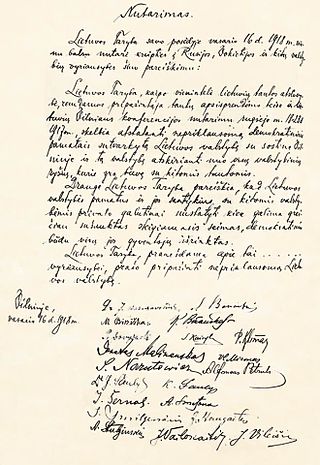
The Act of Independence of Lithuania or the Act of February 16th, also the Lithuanian Resolution on Independence, was signed by the Council of Lithuania on February 16, 1918, proclaiming the restoration of an independent State of Lithuania, governed by democratic principles, with Vilnius as its capital. The Act was signed by all twenty representatives of the Council, which was chaired by Jonas Basanavičius. The Act of February 16 was the result of a series of resolutions on the issue, including one issued by the Vilnius Conference and the Act of January 8. The path to the Act was long and complex because the German Empire exerted pressure on the Council to form an alliance. The Council had to carefully maneuver between the Germans, whose troops were present in Lithuania, and the demands of the Lithuanian people.
The modern banknotes of Lithuania are denominated in litas. All banknotes were of the same size except for the 500 litų banknote. They bore signatures of Minister of Finance and/or of Chairperson of the Bank of Lithuania Board. 10, 20, and 50 litų banknotes had 4 releases. This was mainly due to security reasons: number of security features was gradually increased from virtually 0, to 9, 14 and eventually to 17. The first release bore the date "1991" but were actually released to the public in 1993 for a very brief time (June–October). Since they were replaced in the same year, the first release is dated to 1991 and the second to 1993.

The signatories of the Act of Independence of Lithuania were the twenty Lithuanian men who signed the Act of Independence of Lithuania on February 16, 1918. The signatories were elected to the Council of Lithuania by the Vilnius Conference in September 1917 and entrusted with the mission of establishing an independent Lithuanian state. The proclaimed independence was established only in late 1918, after Germany lost World War I and its troops retreated from Lithuanian territory. What followed was a long process of building the state, determining its borders, and gaining international diplomatic recognition. The signatories succeeded in their mission and independent Lithuania survived until the Soviet Union occupied the state on June 15, 1940.

Petras Vileišis was a prominent Lithuanian engineer specializing in the construction of railroad bridges. He was very active in Lithuanian public life and together with his brothers Jonas and Antanas became one of the key figures of the Lithuanian National Revival.

Antanas Žmuidzinavičius was a Lithuanian painter and art collector.
The Lithuanian National Revival, alternatively the Lithuanian National Awakening or Lithuanian nationalism, was a period of the history of Lithuania in the 19th century at the time when a major part of Lithuanian-inhabited areas belonged to the Russian Empire. It was expressed by the rise of self-determination of the Lithuanians that led to the formation of the modern Lithuanian nation and culminated in the re-establishment of an independent Lithuanian state. The most active participants of the national revival included Vincas Kudirka and Jonas Basanavičius. The period largely corresponded to the rise of romantic nationalism and other national revivals of 19th-century Europe.

The Lithuanian Scientific Society was a scientific, cultural, and educational organization that was active between 1907 and 1940 in Vilnius, Lithuania. It was founded in 1907 on the initiative of Jonas Basanavičius.

Marijampolė Rygiškių Jonas Gymnasium is a secondary school in Marijampolė, Lithuania. It is named after Rygiškių Jonas, one of the pen names of linguist Jonas Jablonskis who was one of the gymnasium's alumni. Established in 1867, the gymnasium was a significant cultural center of Suvalkija and educated many prominent figures of the Lithuanian National Revival. Since 2010, it is a four-year school.
The Lithuanian Literary Society was a literary society dedicated to the Lithuanian language that was active from 1879 to about 1923 in Tilsit, East Prussia. It was the first scientific society dedicated to Lithuanian studies. It sought to document, preserve, and study Lithuanian language, folklore, literature, and cultural heritage. Members of the society were mostly non-Lithuanian scholars and conducted its proceedings in German.
The Lithuanian conferences during World War I refer to ten conferences held by Lithuanian activists during World War I in Switzerland and Sweden. They articulated the vision of independent Lithuanian state free of Russian, German, and Polish influence and as such were an important step towards the Act of Independence of Lithuania in February 1918.
Vincas Basanavičius was a Lithuanian farmer and folklorist, the brother of Jonas Basanavičius.

The Museum of Antiquities in Vilnius was a museum of archaeology and history established by Count Eustachy Tyszkiewicz in 1855 at the premises of the closed Vilnius University. It was the first public museum in the former Grand Duchy of Lithuania and is considered a predecessor of the National Museum of Lithuania even though only a handful of items from the Museum of Antiquities ended up at the National Museum. Together with the Archaeological Commission which functioned as a de facto learned society, the museum was the most prominent cultural and scientific institution in all of Lithuania and displayed many historical items that reminded of the old Grand Duchy and served romantic nationalism of Lithuanian nobles at the time when Lithuania was part of the Russian Empire. The museum collections rapidly grew to over 67,000 items in 1865 by absorbing large collections of minerals and zoological specimens from the closed Vilnius University, libraries of various closed Catholic churches and monasteries, and various donations from local nobles.

The Lithuanian Art Society was a society that organized Lithuanian art exhibitions and supported Lithuanian artists. Based in Vilnius, it was active from 1907 to the outbreak of World War I in 1914. It was chaired by painter Antanas Žmuidzinavičius. The society was established after the first Lithuanian art exhibition was successfully organized in early 1907. The society continued to organize annual exhibitions that displayed works both by professional and folk artists. Influenced by the Arts and Crafts movement, the society paid great attention to Lithuanian folk art which was increasingly seen as an expression of the Lithuanian character. In 1912, the society published an album of drawings of Lithuanian crosses, column shrines, and roofed poles, which is considered the first study of Lithuanian folk art. The society was also instrumental in preserving the art of Mikalojus Konstantinas Čiurlionis and organized his first solo exhibitions in 1911 and 1913. The society also collected works by other artists and worked with the Lithuanian Scientific Society to establish a Lithuanian art museum. The collection was transferred to the present-day M. K. Čiurlionis National Art Museum in 1920.
